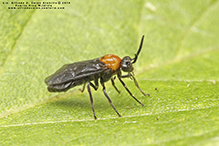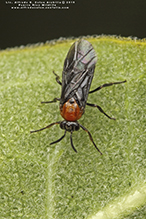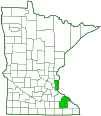Trefoil sawfly
(Atomacera debilis)
Conservation • Description • Habitat • Ecology • Distribution • Taxonomy
Conservation Status |
|||
| IUCN Red List | not listed |
||
| NatureServe | not listed |
||
| Minnesota | not listed |
||
Description |
Trefoil sawfly is a small argid sawfly. It occurs in the eastern United States and in Ontario, Canada. It is uncommon in Minnesota. Adults are stout-bodied and mostly black. The female averages ⅛″ (4.0 mm) in length, the male ⅛″ (3.8 mm) in length. The head is black. There is a raised crest on the upper part of the head. The mouthparts are optimized for chewing. The upper part of the mouth (labrum), which corresponds to the upper lip, the area above the labrum (clypeus), and the area above the clypeus and between the antennae bases (supraclypeal area) are all brownish. The antennae are black and have just 3 segments. The third segment is slender and very long. On the male it has numerous erect hairs. On both sexes it is not forked or U-shaped. On the female, the upper side of the thorax, including the area just behind the head (prescutum), is reddish. On the male the thorax is entirely black. The small plate between the wing bases (scutellum) is reddish, and sometimes has a small or large black spot in the middle. The abdomen is black. The wings are smoky, almost opaque at the base to almost clear at the tip. On the forewing, there are 3 marginal cells. There is an additional vein, the intercostal vein (ic), between the costal (c) and the subcostal (sc) veins. The basal anal cell in the forewing is missing. There is no anal cell in the hindwing. The legs are black. The second segment (trochanter) has 2 segments. The fourth segment (tarsus) on the middle and hind legs does not have a spine just before the tip (preapical spine). The last part of the leg (tarsus), corresponding to the foot, has 5 segments. At the end of each tarsus there is a pair of claws. The claws are simple, not forked, and are sharply bent at over the tip. |
Size |
Male: average ⅛″ (3.8 mm) Female: average ⅛″ (4.0 mm) |
Similar Species |
Hibiscus sawfly (Atomacera decepta) prescutum is black. |
Habitat |
|
Ecology |
Season |
|
Behavior |
|
Life Cycle |
|
Larva Food |
Leaves of tick-trefoil (Desmodium spp.) |
Adult Food |
|
Distribution |
||
|
Sources Key to genera of Nearctic Argidae (Hymenoptera) with revisions of the genera Atomacera Say and Sterictiphora Billberg. Smith D.R. 1969. Trans. Am. Ent. Soc. 95: 439-457. |
|
| 9/25/2025 | ||
Occurrence |
||
|
||
Taxonomy |
|
Order |
Hymenoptera (ants, bees, wasps, and sawflies) |
Suborder |
Symphyta (sawflies, horntails, and wood wasps) |
Superfamily |
Tenthredinoidea (typical sawflies) |
Family |
Argidae (argid sawflies) |
Subfamily |
Atomacerinae |
Genus |
Atomacera |
Subordinate Taxa |
|
|
|
Synonyms |
|
|
|
Common Names |
|
trefoil sawfly |
|
Glossary
Clypeus
On insects, a hardened plate on the face above the upper lip (labrum).
Labrum
The upper part of the mouth, sometimes considered the lower part of the face, corresponding to the upper lip, on an insect or crustacean.
Scutellum
The exoskeletal plate covering the rearward (posterior) part of the middle segment of the thorax in some insects. In Coleoptera, Hemiptera, and Homoptera, the dorsal, often triangular plate behind the pronotum and between the bases of the front wings. In Diptera, the exoskeletal plate between the abdomen and the thorax.
Tarsus
On insects, the last two to five subdivisions of the leg, attached to the tibia; the foot. On spiders, the last segment of the leg. Plural: tarsi.
Tibia
The fourth segment of an insect leg, after the femur and before the tarsus (foot). The fifth segment of a spider leg or palp. Plural: tibiae.
Visitor Photos
Share your photo of this insect.
This button not working for you?
Simply email us at info@MinnesotaSeasons.com.
Attach one or more photos and, if you like, a caption.
Alfredo Colon |
||
 |
 |
|
MinnesotaSeasons.com Photos
|

Slideshows

Visitor Videos
Share your video of this insect.
This button not working for you?
Simply email us at info@MinnesotaSeasons.com.
Attach a video, a YouTube link, or a cloud storage link.
Other Videos




